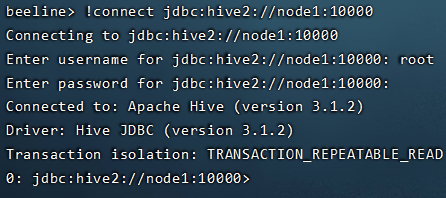第八周学习总结
连接

建表

上传数据

HIVE SQL Load加载数据语句
load data local inpath '/root/hivedata/students.txt' into table student;
HIVE SQL Insert插入数据语句
insert into table student_from_insert select num,name from student;
HIVE SQL Select基础查询语句
--1、select_expr
--查询所有字段或者指定字段
select * from t_usa_covid19;
select county, cases, deaths from t_usa_covid19;
--查询常数返回 此时返回的结果和表中字段无关
select 1 from t_usa_covid19;
--查询当前数据库
select current_database(); --省去from关键字
--2、ALL DISTINCT
--返回所有匹配的行
select state from t_usa_covid19;
--相当于
select all state from t_usa_covid19;
--返回所有匹配的行 去除重复的结果
select distinct state from t_usa_covid19;
--多个字段distinct 整体去重
select distinct county,state from t_usa_covid19;
--county,state
a BBB
c BBB
a BBB
d CCC
a WWW
a BBB
c BBB
d CCC
--3、WHERE CAUSE
select * from t_usa_covid19 where 1 > 2; -- 1 > 2 返回false
select * from t_usa_covid19 where 1 = 1; -- 1 = 1 返回true
--找出来自于California州的疫情数据
select * from t_usa_covid19 where state = 'California';
--where条件中使用函数 找出州名字母长度超过10位的有哪些
select * from t_usa_covid19 where length(state) >10 ;
--注意:where条件中不能使用聚合函数
-- --报错 SemanticException:Not yet supported place for UDAF 'count'
--聚合函数要使用它的前提是结果集已经确定。
--而where子句还处于“确定”结果集的过程中,因而不能使用聚合函数。
select state,sum(deaths) from t_usa_covid19 where sum(deaths) >100 group by state;
--可以使用Having实现
select state,sum(deaths) from t_usa_covid19 group by state having sum(deaths) > 100;
--4、聚合操作
--统计美国总共有多少个县county
select county as itcast from t_usa_covid19;
--学会使用as 给查询返回的结果起个别名
select count(county) as county_cnts from t_usa_covid19;
--去重distinct
select count(distinct county) as county_cnts from t_usa_covid19;
--统计美国加州有多少个县
select count(county) from t_usa_covid19 where state = "California";
--统计德州总死亡病例数
select sum(deaths) from t_usa_covid19 where state = "Texas";
--统计出美国最高确诊病例数是哪个县
select max(cases) from t_usa_covid19;
--5、GROUP BY
select *
from t_usa_covid19;
--根据state州进行分组 统计每个州有多少个县county
select count(county) from t_usa_covid19 where count_date = "2021-01-28" group by state;
--想看一下统计的结果是属于哪一个州的
select state,count(county) as county_nums from t_usa_covid19 where count_date = "2021-01-28" group by state;
--再想看一下每个县的死亡病例数,我们猜想很简单呀 把deaths字段加上返回 真实情况如何呢?
select state,count(county),sum(deaths) from t_usa_covid19 where count_date = "2021-01-28" group by state;
--很尴尬 sql报错了org.apache.hadoop.hive.ql.parse.SemanticException:Line 1:27 Expression not in GROUP BY key 'deaths'
--为什么会报错??group by的语法限制
--结论:出现在GROUP BY中select_expr的字段:要么是GROUP BY分组的字段;要么是被聚合函数应用的字段。
--deaths不是分组字段 报错
--state是分组字段 可以直接出现在select_expr中
--被聚合函数应用
select state,count(county),sum(deaths) from t_usa_covid19 where count_date = "2021-01-28" group by state;
--6、having
--统计2021-01-28死亡病例数大于10000的州
select state,sum(deaths) from t_usa_covid19 where count_date = "2021-01-28" and sum(deaths) >10000 group by state;
--where语句中不能使用聚合函数 语法报错
--先where分组前过滤,再进行group by分组, 分组后每个分组结果集确定 再使用having过滤
select state,sum(deaths) from t_usa_covid19 where count_date = "2021-01-28" group by state having sum(deaths) > 10000;
--这样写更好 即在group by的时候聚合函数已经作用得出结果 having直接引用结果过滤 不需要再单独计算一次了
select state,sum(deaths) as cnts from t_usa_covid19 where count_date = "2021-01-28" group by state having cnts> 10000;
--7、order by
--根据确诊病例数升序排序 查询返回结果
select * from t_usa_covid19 ;
select * from t_usa_covid19 order by cases;
--不写排序规则 默认就是asc升序
select * from t_usa_covid19 order by cases asc;
--根据死亡病例数倒序排序 查询返回加州每个县的结果
select * from t_usa_covid19 where state = "California" order by cases desc;
--8、limit
--没有限制返回2021.1.28 加州的所有记录
select * from t_usa_covid19 where count_date = "2021-01-28" and state ="California";
--返回结果集的前5条
select * from t_usa_covid19 where count_date = "2021-01-28" and state ="California" limit 5;
--返回结果集从第1行开始 共3行
select * from t_usa_covid19 where count_date = "2021-01-28" and state ="California" limit 2,3;
--注意 第一个参数偏移量是从0开始的
--执行顺序
select state,sum(deaths) as cnts from t_usa_covid19
where count_date = "2021-01-28"
group by state
having cnts> 10000
limit 2;
------------Hive Join SQL 语法------------
--Join语法练习 建表
drop table if exists employee_address;
drop table if exists employee_connection;
drop table if exists employee;
--table1: 员工表
CREATE TABLE employee(
id int,
name string,
deg string,
salary int,
dept string
) row format delimited
fields terminated by ',';
--table2:员工家庭住址信息表
CREATE TABLE employee_address (
id int,
hno string,
street string,
city string
) row format delimited
fields terminated by ',';
--table3:员工联系方式信息表
CREATE TABLE employee_connection (
id int,
phno string,
email string
) row format delimited
fields terminated by ',';
--加载数据到表中
load data local inpath '/root/hivedata/employee.txt' into table employee;
load data local inpath '/root/hivedata/employee_address.txt' into table employee_address;
load data local inpath '/root/hivedata/employee_connection.txt' into table employee_connection;
select *
from employee;
select *
from employee_address;
select *
from employee_connection;
--1、inner join
select e.id,e.name,e_a.city,e_a.street
from employee e inner join employee_address e_a
on e.id =e_a.id;
--等价于 inner join=join
select e.id,e.name,e_a.city,e_a.street
from employee e join employee_address e_a
on e.id =e_a.id;
--等价于 隐式连接表示法
select e.id,e.name,e_a.city,e_a.street
from employee e , employee_address e_a
where e.id =e_a.id;
--2、left join
select e.id,e.name,e_conn.phno,e_conn.email
from employee e left join employee_connection e_conn
on e.id =e_conn.id;
--等价于 left outer join
select e.id,e.name,e_conn.phno,e_conn.email
from employee e left outer join employee_connection e_conn
on e.id =e_conn.id;
-----------------Hive 常用的内置函数----------------------
show functions;
describe function extended count;
------------String Functions 字符串函数------------
select length("itcast");
select reverse("itcast");
select concat("angela","baby");
--带分隔符字符串连接函数:concat_ws(separator, [string | array(string)]+)
select concat_ws('.', 'www', array('itcast', 'cn'));
--字符串截取函数:substr(str, pos[, len]) 或者 substring(str, pos[, len])
select substr("angelababy",-2); --pos是从1开始的索引,如果为负数则倒着数
select substr("angelababy",2,2);
--分割字符串函数: split(str, regex)
--split针对字符串数据进行切割 返回是数组array 可以通过数组的下标取内部的元素 注意下标从0开始的
select split('apache hive', ' ');
select split('apache hive', ' ')[0];
select split('apache hive', ' ')[1];
----------- Date Functions 日期函数 -----------------
--获取当前日期: current_date
select current_date();
--获取当前UNIX时间戳函数: unix_timestamp
select unix_timestamp();
--日期转UNIX时间戳函数: unix_timestamp
select unix_timestamp("2011-12-07 13:01:03");
--指定格式日期转UNIX时间戳函数: unix_timestamp
select unix_timestamp('20111207 13:01:03','yyyyMMdd HH:mm:ss');
--UNIX时间戳转日期函数: from_unixtime
select from_unixtime(1618238391);
select from_unixtime(0, 'yyyy-MM-dd HH:mm:ss');
--日期比较函数: datediff 日期格式要求'yyyy-MM-dd HH:mm:ss' or 'yyyy-MM-dd'
select datediff('2012-12-08','2012-05-09');
--日期增加函数: date_add
select date_add('2012-02-28',10);
--日期减少函数: date_sub
select date_sub('2012-01-1',10);
----Mathematical Functions 数学函数-------------
--取整函数: round 返回double类型的整数值部分 (遵循四舍五入)
select round(3.1415926);
--指定精度取整函数: round(double a, int d) 返回指定精度d的double类型
select round(3.1415926,4);
--取随机数函数: rand 每次执行都不一样 返回一个0到1范围内的随机数
select rand();
--指定种子取随机数函数: rand(int seed) 得到一个稳定的随机数序列
select rand(3);
-----Conditional Functions 条件函数------------------
--使用之前课程创建好的student表数据
select * from student limit 3;
--if条件判断: if(boolean testCondition, T valueTrue, T valueFalseOrNull)
select if(1=2,100,200);
select if(sex ='男','M','W') from student limit 3;
--空值转换函数: nvl(T value, T default_value)
select nvl("allen","itcast");
select nvl(null,"itcast");
--条件转换函数: CASE a WHEN b THEN c [WHEN d THEN e]* [ELSE f] END
select case 100 when 50 then 'tom' when 100 then 'mary' else 'tim' end;
select case sex when '男' then 'male' else 'female' end from student limit 3;



 浙公网安备 33010602011771号
浙公网安备 33010602011771号